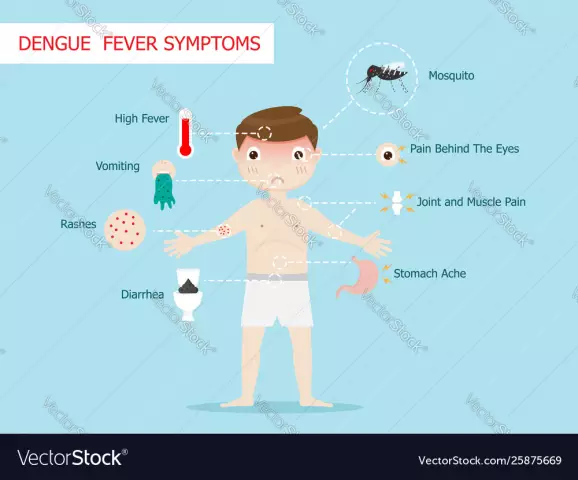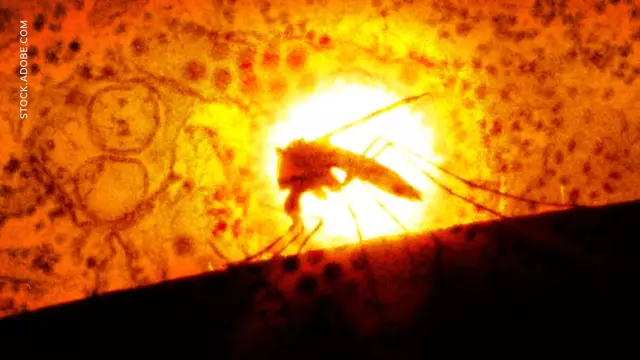- Author Rachel Wainwright [email protected].
- Public 2023-12-15 07:39.
- Last modified 2025-11-02 20:14.
Relapsing fever

Relapsing fever is an acute infectious disease. The causative agents of relapsing fever are lice (epidemic relapsing fever) or ticks (endemic relapsing fever). The disease proceeds with an alternation of attacks of fever and periods of remission.
You can get relapsing fever in all regions except Australia. The greatest likelihood of contracting typhus, and in its most severe forms, is in Africa. So, in Sudan after the First World War, about 100 thousand people died from this disease in ten years.
Relapsing fever is common in India, Russia and the countries of the Balkan Peninsula. In Iran, India, Southeast Asia, epidemic relapsing fever is more common, caused by crowded living in unsanitary conditions. In the countries of Europe, Asia, Africa, South America, lice of the genus Pediculus, parasitizing on humans, are the carrier of relapsing fever.
In the countries of Europe, Asia, Africa, North and Central America, tick-borne relapsing fever occurs. Relapsing fever is carried by ticks of the genus Ornithodorus.
What factors trigger relapsing fever?
The causative agents of relapsing fever are spirochetes of the genus Borrelia. Tick-borne relapsing fever is a zoonotic vector-borne disease caused by various types of borrelia: B. caucasica, B. latyschewii, B. hispanica, B. persica, B. duttonii.
In their biological, morphological properties, these borrelia are similar to the causative agents of epidemic typhus.
Carriers of relapsing fever
The vectors of tick-borne relapsing fever are ticks of the family Argas persicus, Argasidae, which are reservoir hosts of spirochetes. In addition, various types of rodents can be a reservoir of Borrelia. Ticks are contagious throughout their entire life span (approximately 10 years). As a rule, human infection occurs due to a tick bite. Most often this occurs in the warm season during the activation of the vital activity of ticks.
Lice P. humanus humanus (clothes), Pediculus humanus capitis (head) and Phtirius pubis (pubic) are carriers of epidemic relapsing fever. Only people can get sick with epidemic relapsing fever.
The pathogenesis of relapsing fever
When Borrelia enters the human body, cells of the lymphoid-macrophage system are introduced, where they begin to multiply and enter the bloodstream in a much larger quantity. Under the influence of the bactericidal properties of blood, they begin to partially break down with the release of endotoxin, which affects the central nervous and circulatory systems. The defeat of the systems is accompanied by fever, and foci of necrosis appear in the liver and spleen. Borrelia, lingering in the capillaries of internal organs, disrupt the local blood supply, as a result of which hemorrhagic infarction develops.

The first period of the disease, accompanied by fever, ends with the development of antibodies by the body to the first generation Borrelia. As a result, most of the borrelia die, which is clinically reflected in the onset of a period of remission. However, part of Borrelia changes its antigenic properties and becomes resistant to antibodies. They begin to multiply again, and when released into the blood, they cause a new attack of fever. Antibodies against the second generation of Borrelia also destroy most of them, but not all. This again provokes a relapse of the disease. Full recovery occurs only when a full spectrum of antibodies appears in the blood, destroying all mutations in barrels. At the same time, after recovery, persistent immunity to this disease does not arise, since antibodies remain in the body for a short time.
Relapsing fever symptoms
The first attack of relapsing fever begins suddenly. The patient feels a short-term chill, which is replaced by an increase in temperature. Headache, muscle and joint pain, vomiting, nausea appear. The temperature rises rapidly, the skin becomes dry, the pulse quickens, and delirium occurs. The peak of the attack is accompanied by the appearance of a rash on the skin, the development of jaundice, and an enlarged liver and spleen. During a fever, pneumonia or bronchitis may develop, and signs of heart damage are noted. The first attack lasts 2-6 days. Then comes the period of remission, the patient's well-being improves. But after a few days, a second attack of the disease develops, which has similar symptoms.
For epidemic relapsing fever, several similar attacks are characteristic, which, as a rule, end in full recovery and the onset of temporary immunity to the disease. For tick-borne relapsing fever, four or even more similar attacks are characteristic, which, however, have milder symptoms and last less. But it happens that the second attack is much more difficult than the first.
Relapsing fever is fraught with the development of complications: uveitis, meningitis, synovitis, rupture of the spleen, iridocyclitis, iritis.
Diagnosis of relapsing fever
Diagnosis of the disease is based on epidemiological data and clinical manifestations. The study of peripheral blood plays an important role in the diagnosis of relapsing fever. During an attack, it is quite easy to detect the pathogen in the patient's blood.
Relapsing fever treatment
Treatment of epidemic relapsing fever consists in the use of antibiotics (chloramphenicol, penicillin, chlortetracycline), as well as arsenic preparations (novarsenol).
For the treatment of endemic relapsing fever, antibiotics of the tetracycline group, ampicillin, chloramphenicol are used.
Prevention of relapsing fever
Disease prevention is reduced to the fight against pathogens. Contact with lice-ridden patients should be avoided. Currently, in our country and in a number of other countries, epidemic typhus is a fairly rare disease.
Prevention of endemic relapsing fever is to protect people from contact with ticks, as well as the destruction of rodents and other vectors in natural foci.
The information is generalized and provided for informational purposes only. At the first sign of illness, see your doctor. Self-medication is hazardous to health!






